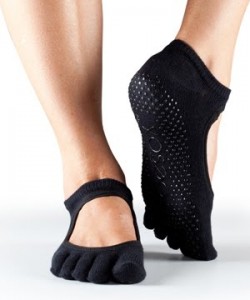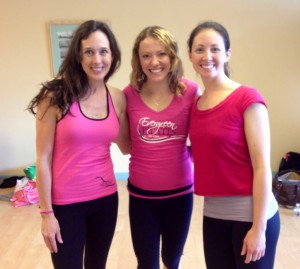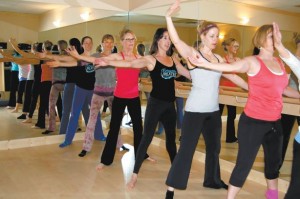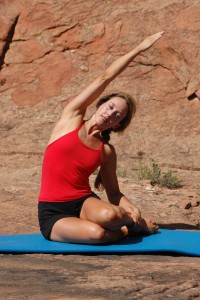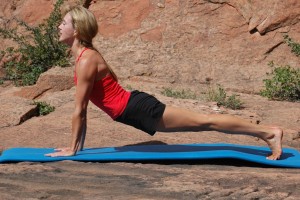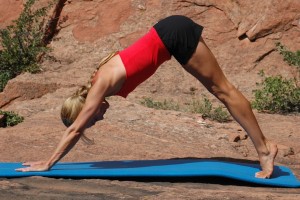Did you know that the average American will consume 3,000 calories during their Thanksgiving meal? And, if we add all the snacks throughout the day, that number edges up to 4,500 calories. Yikes! I am not a big calorie counter, but I will tell you that 3,500 calories makes one pound. Do the math. Its easy to see how weight is gained fast. Overeating throws off our metabolism, energy, and immune function leaving us vulnerable to illness and disease. 75% of men, and 65% of women in America are overweight. Obesity is now the leading cause of heart disease, diabetes, and cancer. Many people are surprised when I say, “Yes, we have classes on Thanksgiving morning.” Honestly, can you think of a better time to exercise? This is the time when we most need the support and consistency of our routine to maintain our health and fitness goals. Here’s a nice bonus. According to the American Council on Exercise, your metabolism stays elevated for as many as 24 hours after you finish exercising. How many calories you continue to burn depends primarily on the intensity of your workout. So by all means, perform the Hundred with vigor! It stands to reason that by working out on Thanksgiving morning, maybe a dollop of whip cream on our pie would be a sweet treat! Join us Thanksgiving morning: 8:15am 9:15am 10:15am
Flattering & Functional
Running… from the ground up!
Picture the stride of a strong runner. Is it fluid and energy and efficient or choppy and wasteful? Chances are it is characterized by vertical alignment from the ears to the ankles, feet landing below the body, relaxed shoulders and steady breathing. A strong runner stabilizes from the core, moves forward landing on the mid-foot and minimizes up-and-down and side-to-side motion. Now envision the stride of a struggling runner. Does she break at the hips, lean too far forward or bounce up and down? Does she run with tense shoulders, clenched fists, a swayed back or practice shallow breathing? Chances are good that more energy is being expended, thereby causing more impact. The quality of a runner’s posture, fitness and breathing can mean the difference between a fluid and efficient stride and one that leaves her hobbling. How we use our feet can mean the difference between tapping into a core that supports proper body alignment, rather than one that leads to injury. From the time of toddlerhood, most people spend more time wearing hard soled shoes than being barefoot. With the exception of martial arts, dance, yoga and Pilates, virtually all other exercise is practiced wearing shoes. Since running begins with the feet, improving foot strength, flexibility and function go a long way toward preventing problems down the road. Faulty foot biome- chanics can lead to injuries not only to the feet but also to the knees and hips. Bunions, iliotibial band tendonitis, patellar tendonitis, pir- iformis syndrome, sciatica, shine splints and SI (sacroiliac) dysfunction can result from foot misalignments. Foot problems create muscle imbalances and place excess tension on the soft tissues of the joints. Likewise, the strength and flexibility of your legs, hips and core impact how the feet function. Here are three Pilates exercises that are sure to help you improve foot, leg and hip strength and flexibility. For best results, practice these exercises 3-5 times per week. These exercises and others can be learned by attending Barre-Elevate at Evergreen Pilates. Barre-Elevate is a standing Pilates-based workout that not only strengthens the feet, but improves balance, strength and flexibility in the entire body. Foot WorkPurpose: Improves foot, leg and hip strength, while strengthening the core. Begin standing with your feet and knees together. Think of each foot having a tripod beneath it. Make contact across the entire ball of your foot and under your heel. Level your pelvis by letting your sit bones drop straight to the floor. Pull your navel to your spine. Rest your ribs directly over your hips, and your shoulder and head on top of your ribs. Lift your heels off the floor. Keep them touching and the inside of the legs zipped together. Bend your knees. Pretend you are sliding about six inches down a wall. Then press through your feet and squeeze the legs straight. Maintain good alignment from your feet all the way up through the crown of your head. Do 10 repeti- tions. Repeat exercise with your feet and knees rotated outward at a 45 degree diagonal (also known as Pilates-V). Take care that your knees stay in line with your toes. Do 10 repe- titans. Pilates-Style RunningPurpose: Strengthens and stretches feet and calves. Helpful for avoiding plantar fasci- itis. Stand on the edge of a step with the balls of your feet parallel and hip width apart. Allow your heels to extend from the end of the step. Alternate reaching one heel down as the other knee bends. Maintain good posture with a level pelvis, shoulders down and back, and head balanced. Do 10 repetitions per foot. Foot Work with Stretch BandLie on your back with a stretch band or strap over the arches of both feet. Hold onto both ends of the strap and press your legs upward toward the ceiling. Relax your shoul- ders and lengthen your spine onto the mat. Flex and point both feet in the strap, keeping feet and knees parallel. Take one foot out and lengthen your leg along the floor. Flex and point the foot in the strap. Switch feet and repeat. Practice 10 repetitions per foot.
PILOXING…Sleek, Sexy, Powerful!
How does burning between 400-900 calories in one hour sound? If you’re serious about losing inches and toning up, then you’ve got to try Piloxing; an interval workout that combines Pilates, boxing, & aerobics. Last weekend, Evergreen Pilates hosted a Piloxing teacher training workshop with Master trainer Jordan Ballard from Los Angeles. After 8 hours of Pilxoing, 15 ladies finished the day eager to introduce Piloxing to their home studio. Among the graduates was our very own Nicole Wong. Please join us for Piloxing on Tuesdays and Thursdays at 7am, and Wednesdays at 5:30pm.
Tuesdays Together: Open House May 8th 5pm-7pm
With Mother’s Day right around the corner, our May Open House focus is “Gratitude”. Let us show you our appreciation with complimentary Massage and Paraffin Hand Wax treatments from “TallGrass Spa”, delicious food from “In Good Taste Catering”, savory coffee and tea from “EverBean”, and samples from Bella Vita. There will be fabulous Pilates door prizes and specials on classes. And, if you’d like to show your appreciation for someone you love, enjoy specials on Bella Vita’s exclusive Bed & Bath products, Terrariums from Nellybelle, and custom jewelry from Avella Designs. We hope to see you there!
Come Hike with Us!
Today was our very first “Pilates Hiking Club” class, and what a perfect morning, sunny and 60. If you want to do Pilates, need a cardio workout, and love to be outdoors, this class is for you! Step outside the studio and enjoy some of the most beautiful trails in Evergreen!
Walking up gentle slopes, we found new mindfulness of our breathing, gait, and posture. We stopped along the way, making use of boulders and rocks for core, arm, and leg exercises. We biceps curled while listening to a babbling stream, and enjoyed core work with a cool breeze on our foreheads. Some 25 minutes into our hike we reached our summit and celebrated with Mountain Climbers, Planks, and Stepping Up & Down. As we made our descent to the studio, we partnered with Doug Firs and Ponderosa Pines for Leg Circles, and completed our trek with Leg and Hip stretches on an opportunistic fence. What a lovely way to workout and begin the day!
Join us for The Pilates Hiking Club: Tuesdays 9:15am / Friday 11:15am
Sign up on-line: www.evergreenpilates.com
Evergreen Pilates in the Denver Post “Your Hub”
Interview with Lauri Stricker, owner. By Karen Groves of the Denver Post.
How did you get involved in this business?
I discovered Pilates when I was working in advertising sales and had a client named Richard Rossiter who owned a Pilates studio. He encouraged me to take classes. I was an avid rock climber and soon found Pilates to be excellent cross-training for my climbing. Without intending to do so, Pilates helped me to heal an injury, and I started climbing harder than ever. After almost a decade in marketing, I left my career and spent two years training before receiving my certification from The Pilates Institute of Boulder. Since then, I have become a Pilates Method Alliance certified teacher, and have completed the Masters Program at the Pilates Center in Boulder. In 2007 I published a book titled “Pilates for the Outdoor Athlete†(Fulcrum). I have also produced a DVD with my son titled “Pilates With Your Baby.â€
What distinguishes you from other businesses in your category?
Evergreen Pilates is distinguished by its intimate and supportive culture. Every day I see friendships made and lives changed because of the support offered not only by teachers, but also from participants to each other. Because our classes are small (six to eight people at most), you are guaranteed to be supported. My vision for Evergreen Pilates is to maintain the integrity and excellence of Joseph Pilates’ method and to facilitate greater health and well-being in my clients. I have a long-term interest in developing relationships with my clients and helping them in their pursuit of health and happiness.
What do you like best about your line of work?
I like seeing people’s lives changed. Pilates empowers people. They learn how to move in their bodies in ways they never knew possible. Whether it’s a client who has lived with chronic pain for 15 years and is now enjoying pain-free lifestyle, or a grandmother who has regained her fitness to enjoy skiing with her grandkids — Pilates is more than exercise. Pilates restores strength, flexibility and balance.
Pilates Cross-training for Cyclists
Posture, pedal cadence, and technical skill make the elite rider shine. Whether you are riding a century or tackling mountain-biking obstacles, physical and mental fitness contributes to better balance, agility, and handling skills. To maintain a low aerodynamic position and maximize pedaling efficiency, a rider must possess core strength, flexibility, and good alignment. Technical skills such as standing, sprinting, and hopping require upper-body strength. Dealing with obstacles and persevering when the going gets tough require mental fortitude. Improving your mind-body connection begins with improving your breathing.
Road cycling and mountain biking utilize the same major muscle groups yet build fitness slightly differently. Road cycling builds fitness by maintaining constant cruising speeds over long periods of time, whereas mountain biking builds fitness by placing variable demands on a cyclist’s energy and power. The cross-training needs of the two vary in that a mountain biker requires more upper-body strength, agility, and balance, while a road cyclist requires leg strength, cardiovascular fitness, and pedal technique. By participating in both types of riding, you can further improve your overall fitness and riding skills.
Whether you’re a roadie, dirt lovin’ mountain biker, or a recreational cyclist, Pilates will help you ride smoother, pedal longer, and avoid injury. While cycling improves cardiovascular fitness and lower-body endurance, Pilates boosts core strength, flexibility, and muscle balance. Core strength is essential to maintaining a still torso while the legs generate force by pedaling. If your core is weak, the force generated by your legs will be absorbed into your back. A strong core is key to achieving pedaling power and efficiency. By stretching your upper body, you will gain greater range of motion and health in your shoulders, arms, and torso. By improving flexibility and muscle balance, you’ll improve your alignment and overall enjoyment of your ride.
Here are three Pilates exercises that are sure to help you minimize energy expenditure, be less prone to injury, and experience a more comfortable ride. For best results, practice these exercises 3-5 times per week.
1. Mermaid (Pilates for the Outdoor Athlete, page 215)
Purpose: Stretches the obliques, shoulders, and hips.
Sit on your mat, bend your knees to the side. Stack your knees and ankles. Hold on to your top ankle with the hand closest. Bring the other arm up by your ear. INHALE; stretch your raised arm up over your head in the direction of your feet. EXHALE and come back up to center and bring the top hand down to the floor and the hand that helped the ankle up toward the sky. INHALE and side bend away from your feet. Repeat 3 times in each direction. Extra Challenge: To increase the hip stretch, cross your leg and place your top foot beside your knee.
2. Snake (Pilates for the Outdoor Athlete, page 190).
Purpose: Strengthens the back and muscles along the spine. Stretches the chest and the front of the shoulders. Improves balance.
Begin sitting on one hip, extend your legs out long with your top foot in front of your bottom foot. INHALE and rotate the back of your hips up toward the sky so your arms and legs are straight and you are on your toes. EXHALE and extend through your spine. Lift your sternum and draw your shoulders down, and knit your ribs together. Repeat 3-5 times and switch sides.
3. Pigeon Pose(Pilates for the Outdoor Athlete, page 216).
Purpose: Stretches your hip flexors and extensors, chest, shoulders, and abdominals.
Begin on your hands and knees with your shoulders slightly behind your hands. Bring your right knee toward your right wrist and angle your ankle toward your left wrist. Slide your left leg behind you back so the front of your thigh is on the floor. Press up with your arms, draw your shoulders down, and lift your sternum. You may also do this stretch by lowering your torso and resting it on your inner thigh Keep your core engaged. Switch sides.
Why do Athletes need Pilates?
When I first started Pilates I was an avid rock climber dedicated to a rigorous training schedule with the goal of climbing harder and longer routes to no end. Needless to say, I had great endurance and strength. And one more thing – I thought I was really flexible. I could stem between footholds five feet apart, high step up to my elbows and do crazy cross-through moves. Yet my muscles had no strength or flexibility support my spine in something as natural as a backbend. My spine was as stiff as a board. According to Joseph Pilates, “If your spine is inflexible at 30 you are old, if it is flexible at 60 than you are young.” What I perceived as great flexibility and range of motion were actually hyper-extended (locked out) and stressed knees, elbows, and shoulders. But it wasn’t until I injured my shoulder that I took a closer look at my overall fitness. I discovered muscles imbalances from years of climbing that had created vulnerability and lead to my injury.
How your body looks and performs are incomplete measurements for evaluating the muscle balance of your body. Sculpted biceps, triceps, pecs, and a six-pack have many athletes believing that they are as fit as a fiddle. But what about less showy muscles like the rotator cuff or transverses abdominus? Your rotator cuff consists of four shy muscles that form a mighty team holding your arm in your shoulder socket. Climbers, golfers, paddlers, and swimmers all benefit from a strong rotator cuff. The transverse abdominus doesn’t get the hype that the “six-pack” rectus abdominus gets – yet it supports your spine, keeps your back injury free, and enables you to be infinitely more powerful.
Sports by definition require repetitive movement that creates muscle imbalances. Have you ever tried to guess what sport someone does based on his predominant muscle mass? Cyclists are easy to spot – quads of steel. So are climbers – forearms the size of bricks and lats like boat oars. As athletes, we tend to overdevelop some muscles and underdevelop others. The outcome: lack of flexibility, poor biomechanics, and joint instability that leads to common injuries such as tendonitis, bursitis, and dislocations. For athletes, keeping muscles balanced is vital to avoiding injury. Pilates can help you maintain and/or regain the integrity of your body.
Pilates is unique in that it seeks to balance your whole body. Rather than isolating muscles of your body and working repetitions like mad to get them strong – Pilates demands that your entire body work during each repetition. Pilates demands mindfulness and a commitment to mastery, verses mindlessly motoring through a workout. As you switch from one movement to the next, you’ll build flexibility, strength, and stamina. Pilates strengthens and stretches all parts of your body, front to back, left to right, and top to bottom. Depending on your sport, you’ll have different strengths and weakness and benefit from different exercises. Regardless, the goal of all Pilates exercises is to create uniform muscle balance. By grouping mat exercises together that compliment each other in a cross-training routine, as suggested in my book Pilates for the Outdoor Athlete (Fulcrum 2008), Pilates can transform your fitness. With consistent practice, patience and commitment to the Method, you will create a body that is uniformly strong, flexible and resilient.
Hiking & Pilates Cross-training
Snow soaked ground, warm sunshine, and a high mountain breeze weaving the Ponderosa and Douglas Fir, carry me along a trail that glistens like a river. I am moving, breathing, and alive.
Going by foot allows us to slow down, to be present, to connect with our world and ourselves. Whether your thoughts are quiet or active, one thing is constant… the quality of your stride creates a ripple throughout your entire body. Most people take about 2,000 steps for every mile they hike. The average hiker steps about 8,000 times per hour. The quality of your gait influences the wear and tear on your joints.
A good gait minimizes energy expenditure, reduces impact on your back and knees, and ensures a more comfortable outing. An optimal stride makes contact through the heel, rolls onto the ball of the foot, and presses off to propel you forward. In addition, standing up tall improves joint range of motion, takes pressure off your back, and improves your breathing. A strong core helps you to stay light and lifted over your feet. Boosting core strength also improves your balance and agility so the next time you cross a river, hop a boulder field, or traverse a snowy slope, you’ll have more confidence. Pilates can help you improve your gait by improving your posture, muscle balance, and core strength.
Here are three Pilates exercises that are sure to help you reduce your risk of injury as you hike terrain that slopes and changes with every step. You’ll spend more days light on your feet, and in your heart. For best results, practice these exercises 3-5 times per week.
One Leg Circles (Pilates for the Outdoor Athlete, page 136)
Purpose: Balances the muscles of the legs and hips, improves core strength and alignment.
Begin by lying on your back. Extend one leg along the floor and flex your foot as if pressing it against a wall. Press the back of your leg into the floor. Extend the other leg up toward the sky and point your toes. Engage your core by pulling your navel to your spine. INHALE, sweep your raised leg horizontally across the midline of your body, down an EXHALE up to the starting point. Keep your circle size within the borders of your mat. Although the exercise is called leg circles, imagine you are drawing ovals on the sky. 5 clockwise, 5 counterclockwise on each leg.
Shoulder Bridge with Kicks (Pilates for the Outdoor Athlete, page 152).
Purpose: Strengthens and stretches legs and back, and improves posture.
Lie on your back. Press your arms gently into the mat by your sides so that your chest is open and the front of your ribs recede into the mat. Bend your knees and bring your feet hip-width apart, toes pointing forward. Peel up your spine one vertebra at a time off the mat, beginning with your tailbone until you are resting on your shoulders with an open chest and an engaged core. Straighten and extend one leg and point your toes so your knees are touching. INHALE, kicking up to the sky. Avoid arching your back or letting your hips tilt or lower and lift. EXHALE, flex your foot, and extend the leg down, keeping it straight. Pretend your leg is a paintbrush and you are painting a straight line of your favorite color on the sky. After 5 -10 kicks, repeat with the opposite leg.
Leg Stretch with Band (Pilates for the Outdoor Athlete, page 214).
Purpose: This is a great after hike stretch for the Iliotibial-band, legs, and hips.
Begin lying on your back with your legs out straight. Bring one leg toward your chest and place a stretch band beneath the sole of your foot. Gently lengthen the leg upward, pressing through the heel. Keep your shoulders down and the back of your neck lengthened. From this position, gently pull your leg across the midline of your body until you feel a stretch along the outside of your leg and into the back of your hip. Hold the stretch band with the opposite hand. Switch legs.

